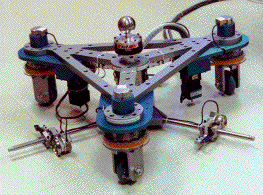 scooter cobot for guiding
horizontal movements in position and orientation
scooter cobot for guiding
horizontal movements in position and orientation
Excellent Students
wanted for this project in collaboration with Northwestern University.
Get a NUS degree and US experience in a leading Robotics lab!
The goal of this project is to develop a simple method to program surfaces resulting in an optimal collaboration of the cobot and the human operator. Using a classical optimization framework to compute these surfaces may be not very useful, as the forces exerted by the operator during movement and his/her comfort can hardly be considered. This project's idea is to put the operator in the loop. We will provide him/her ways to modify and improve the cobot command trial after trial. The surfaces will be coded as B-splines, i.e. be defined as a linear sum of "attraction points". Two ways will be investigated to design and modify the surface: i) by recording movements performed by th e operator ("teach pendant mode") and ii) by using a computer mouse to place/move attraction points on a monitor on which the path and the environment are represented ("CAD mode"). Possible combination of these two modes may also be examined.
As for conventional robots, the teach-pendant probably is the simplest way to define a surface. During the initial movement, the cobot will be in free mode. The path driven will define the guiding surface that will be used from the second trial on. The operator will be able to bend this surface by pushing/pulling it, i.e. by applying a force on the surface. The deformation magnitude can be tuned using a parameter, and the operator will decrease this parameter to "stiffen" the surface when he/she feels that it is becoming optimal.
The benchmark task will consist of putting a pin fixed on the "scooter"
cobot (above figure) into a fixed hole. The developments may be useful
for spatial cobots also, e.g. for executing precision tasks using Carl
Moore's arm cobot. The cobot and corresponding forces will first be
emulated using a 3 DOF haptic
interface and a computer monitor for visual display in Singapore. Then
experiments will be performed at Northwestern
University to test and extend the strategies.
![]() back to Etienne BURDET homepage
back to Etienne BURDET homepage
January 2000, by Etienne Burdet